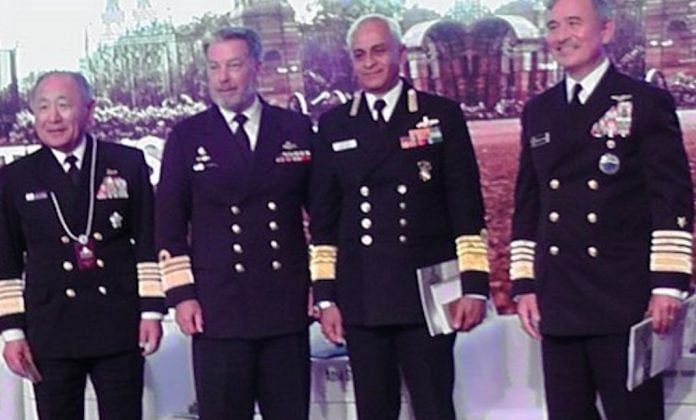At the Raisina Dialogue, the four countries’ military leaders talked unabashed about the India-US-Japan-Australia grouping. It sends a message to China.
An ‘innocent’ question by a Chinese delegate lightened the mood briefly at the very serious Raisina Dialogue this week. A senior researcher from Shanghai wanted to know if Beijing could also apply for membership of the ‘quadrilateral’ – a grouping of India, the US, Japan and Australia in the Indo-Pacific region.
The query generated a few chuckles, but the point was not lost on anyone. There was no restraint or hesitation in the responses of the panel of top military leaders of the four nations. Old diplomatic hypocrisies and caution have yielded to pragmatic clarity and firmness.
From being the word that should never be uttered to becoming accepted nomenclature that now describes India’s approach to a growing Chinese influence in the region – the quadrilateral has come a long way in the past two years.
No one wants to call it an alliance yet, but the ‘association of like-minded nations’ is now firmly in place. The objective is to ensure that China, the big boy in the region, plays by the rules of the international order, and does not bully its way around smaller nations with its overpowering economic might.
The question is, can India take the lead? This requires tough decisions – massive investments into the Navy and unlocking the potential of India’s island chains.
Quad talk was central at the annual Raisina Dialogue – which has become India’s top forum on foreign policy – and three striking points could sum up what it signifies and the challenges faced.
The military edge
Days before the conference, any lingering doubts about the quad were cleared by Indian Army chief Gen. Bipin Rawat. In his annual press conference, the General raised concerns about Beijing’s growing interference in countries around India, explaining that the quadrilateral has been formed “with an assertive China” in mind; that it is not an alliance but a grouping with nations to ensure that “we are not isolated completely in Asia”.
Several such associations exist around the world, but what makes the quad different is the unsaid but very obvious military connotation it implies.
The annual Malabar naval exercise that India undertakes with the US and Japan will see the return of Australia this year; bilateral military ties between all nations in the quadrilateral have never been better, and enabling mechanisms are fast being put into place to share real-time intelligence.
The border standoff at Doklam and a continued, unusual PLA deployment there only appear to have strengthened the Indian resolve to bring in force multipliers into the equation.
For the first time, top military leaders from all four nations of the quad spoke together on a panel at the Raisina Dialogue – yet another indicator of the military edge the grouping signifies.
Like-minded nations
The quad is an association of like-minded nations that brings each one unique challenges or opportunities.
China is wary of the quad and will not hold back in trying to prove that the grouping is aimed only at its containment. Beijing will counter it with its own grouping of nations, wedded together by its investments in connectivity projects.
The US not only initiated it, but will continue to be the strongest backer of the quad. US Pacific Command chief Admiral Harry Harris called 2018 the year to make some “courageous decisions” on taking the quad ahead, calling out China as the disruptive force in the region.
Japan has experienced Chinese expansionism in the seas first hand and is coming in bruised. The Japanese Chief of Joint Staff Admiral Katsutoshi Kawano spoke openly about Beijing’s continued attempts to change the status quo, with its powerful PLA Navy being central to all plans.
Australia, which has been through several multilateral forums and combinations in the past, will be on guard against this being yet another grouping that does not seem to go beyond the corridors of power and paperwork. Australian Navy chief, Vice Admiral Tim Barret, therefore emphasised on the need to follow through on the talk for hard outcomes.
The India approach
The only nation that can drive the grouping towards any meaningful outcome is India. It is not only central to the quad but will need to take a leading position if the strategy is to join hands to check Chinese influence in its backyard.
At the dialogue, BJP general secretary Ram Madhav shared how one of the new foreign policy realisations has been that focus needs to change from a land-based approach to security and to a sea-based approach. Last year, his powerful think tank, the India Foundation, held a special seminar in Port Blair – the first security-linked conference in the Andaman & Nicobar Islands.
The mindset certainly has changed. But to take the lead, India needs to move in two critical areas.
The Navy has to be expanded – at the cost of the Army if need be – with platforms that can project power and presence across the Indian Ocean Region. And, island chains – especially Andaman & Nicobar – need to be strengthened with infrastructure and capability that will give India strong arms to reach out much deeper into the region.
While the government has been working on both – the pace leaves much to be desired. It is also a question of economic priorities – the resources required are way beyond current spending. An indication, perhaps, for the resolve that can be shown in the budget projections next month.






